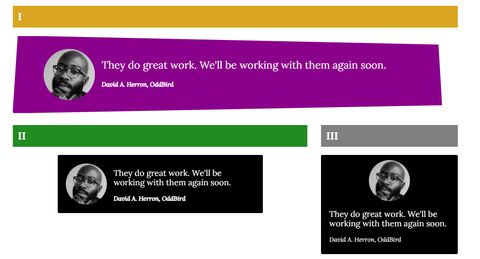How do we move logical shorthands forward?
There are several proposals, but one major road block
We’re trying to make progress on shorthand syntax for CSS logical properties. But the path forward depends on where we hope to be a decade from now.

Now is the time to begin experimenting with a long requested layout tool.
The @container query, that elusive feature developers have been requesting
and proposing for years, has finally made its debut in a browser. Well, sort
of. Here we’ll explain what container queries are, how they work, and what
other features they might come with once fully supported in browsers.
🥳 Container queries have been available to use in all major browsers since February 2023. We’ve updated the guide with changes and developments that have happened since we first published.
In the latest version of Chrome Canary,
the most recent @container query proposal is available for use behind an
experimental flag. Developed by OddBird’s own Miriam
Suzanne, the
draft builds upon the ideas
previously proposed by other web standards experts like David Baron, who wrote
the original
draft.
@Media queries sparked a responsive design revolution by allowing authors to
change the style of elements based on the size of the entire viewport. Up until
now, what could not be done was changing the style of an element based on the
size of one of its nearest containers.
The proposed @container query syntax feels a lot like writing a @media
query, but a main difference is that a @container query has to be implemented
in two parts.
In this demo (which only works in the latest version of Chrome
Canary), a blockquote is styled
differently depending on the size of its container.
See the Pen Container Queries with Block Quotes by @dvdherron on CodePen.
To achieve this, first define a containment context. This lets the browser know which container to query against later and how exactly to query that specific container.
article,
section {
container-type: inline-size;
}The container-type[1] property turns on containment for the
selected elements, allowing for the testing of aspects such as style, size, and
state.
The inline-size value specifies that, in this case, queries will be made
against the containing element’s inline
axis.
Layout and
size[2] containment are applied automatically
as well.
(Block-size is also being considered as a containment type in the new
proposal. Inline-size seemed to satisfy more use-cases, so is being developed
first.)
Inline-size containment has been well-supported since container queries were
supported in stable versions of browsers.Layout containment was previously applied automatically when
container-type and container-name properties were used. It has since been
removed from the container queries specification, but is still applied in some
browsers that have not updated their implementation of container queries.block-size containment proved to be impossible and has since
been abandoned.size containment type, which queries in both the inline and block axes,
has been available as a containment type in all browsers since February 2023.
Setting container-type: size allows for querying the container’s orientation
and aspect-ratio in addition to its size.Containers can also be named:
article,
section {
container-name: demo;
container-type: inline-size;
}And the container-type and container-name properties can be combined by
using the container shorthand property:[3]
article,
section {
container: demo / inline-size;
}
@container demo (min-width: 30em) {
.element {
/* styles to apply */
}
}Now that a containment context has been defined, the @container rule is used
to tell the browser when and how styles should change inside each container.
With a narrow parent container, the blockquote features the image stacked on
top of the text.

At the first breakpoint, the layout for the blockquote changes so that the
profile image moves from being above the quote to sitting next to it, and the
text describing the speaker gets a heavier weight applied.

/* change styles according to container size */
@container (min-width: 35em) {
.quote {
grid-gap: 1rem;
grid-template: "media quote" auto/ max-content 1fr;
}
.media {
align-items: center;
}
.source {
font-weight: bold;
}
}At the second breakpoint, the size of the text for the quote and the attribution
grows, the background changes color, and the overall shape of the blockquote
changes by way of a clip-path.

@container (min-width: 60em) {
.quote {
--quote-size: 1.5rem;
--quote-background: darkmagenta;
clip-path: polygon(
-0.04% 100.6%,
1.12% -0.52%,
95.65% 11.18%,
96.46% 90.05%
);
padding: 1.25em 3em;
max-width: unset;
}
.source {
font-size: 1.1rem;
}
}Any styles inside of one of these @container blocks will be applied when the
container fulfills the condition of the query.
Just as with @media queries, authors can write as many @container queries as
needed.
With each blockquote sitting in a different sized container, they all look
slightly different, at the same viewport size.

It’s still very early in the proposal process, so a lot regarding how container queries work could change.
aspect-ratio,
orientation, or even custom properties and layout
states.vh and vw.
Container-relative units
could be on the horizon as well.Container-relative units have been available to use in all major browsers since February 2023.
Most Chromium based browsers added support for
scroll-state
containment in February of 2025. As of this update, it’s available in a
browser preview version of Opera.
Style queries – the ability to query a computed value of a containing element – have been partially implemented by most browsers (no support in Firefox yet). The current implementation allows for the querying of custom property values:
@container style(--theme: light) {
/* styles to apply here */
}Browsers are still working on adding support for using style queries to
evaluate booleans (@container style(gap) {...}) and property-value pairs
(@container style(display: flex) {...}).
Size queries have made it possible to now query a containing element’s
aspect-ratio and orientation.
Bookmark Miriam’s scratch site for updates: Miriam’s CSS Sandbox.
To participate in discussions and implementation questions related to
container queries, visit this project board: Open Issues & Work on the
Contain 3 Spec.
Follow these steps to get started experimenting and making your own demos:
chrome://flags.Enabled.The OddBird team would love to see what you come up with. Tag us on Twitter with a link to whatever you create. In the meantime, check out our collection of demos on CodePen for inspiration.
Syntax for establishing a containment context was updated
July 14, 2021 to use the new container-type and container-name
properties instead of contain. ↩︎
A previous
version of this article listed style and layout as required values for the
contain property when establishing a containment context. These values are now
automatically applied when using the new container-type and container-name
properties. Updated July 14, 2021. ↩︎
The two values of the shorthand
were originally reversed, with container-type and then container-name.
Updated August 18, 2022. ↩︎

There are several proposals, but one major road block
We’re trying to make progress on shorthand syntax for CSS logical properties. But the path forward depends on where we hope to be a decade from now.

Can we get this process unstuck?
The CSS Working Group recently resolved to add a size shorthand for setting both the width and height of an element. Many people asked about using it to set the ‘logical’ inline-size and block-size properties instead. But ‘logical shorthands’ have been stalled in the working group for years. Can we…

It’s not just a shorthand for anchor()
position-area might be my favorite part of the CSS Anchor Positioning spec, with a ton of features packed in to make things just… work. But there’s no magic here, just a few key parts that work well.